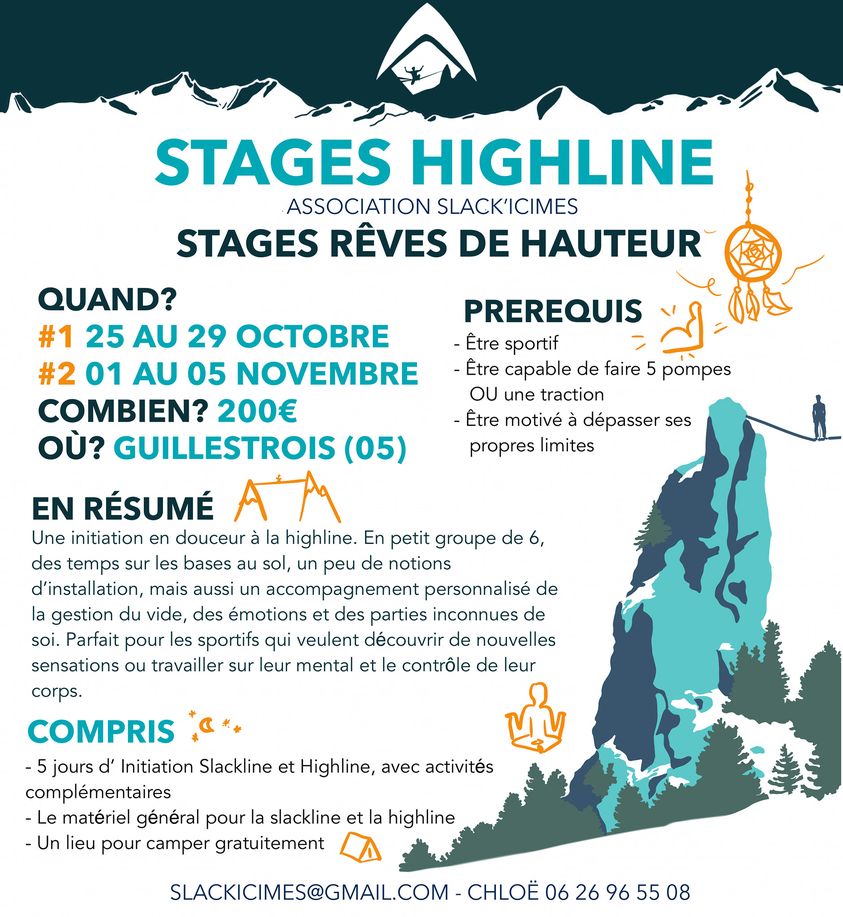Highline
Summary
2. The 7 commandments of highlining
- #1 Never practice alone
- #2 First installation
- #3 Know your equipment
- #4 Choose the right spot
- #5 Requirements : know your limits
- #6 Safety
- #7 Respect people and the environment
3. Where i can highline ? Who can i highline with ?
4. Requirement equipment for highline
1. What is highlining ?
Aerial variant of slacklining, highlining is the queen discipline. Its goal is to walk in the void on a slackline rigged several dozen or even hundreds of meters high, secured by a harness. Extreme sensations guaranteed!
Highlining is the leading activity of slacklining because this style of practice offers the most breathtaking spectacles. Often seen on tv or on videos, it leave no one cold !
Very spectacular, the discipline is not without risk. The highliner (the one who is on the slackline) is leashed to the webbing via a harness, therefore it is important to install correctly all the equipment to ensure his safety and to let him enjoy the sensations!
A proper setup, different from other styles of practice
In highlining, in addition to the webbing on which the highliner walks : called mainline ; it is mandatory to install a lifeline to secure the installation : called backup.
The backup is independently rigged under the mainline. They are only connected by adhesive tape so that the highliner does not get tangled with its feet in it when crossing or falling. The highliner is attached to both lines at the same time by a ring (called leashring) and a climbing harness. Thus, if a problem occurs on the mainline (a webbing breakage), the highliner is caught and secured by the backup (lifeline).
The simplified diagram below clearly lay down the main principles of rigging a highline.
It is meant to serve only as an example, it cannot be considered as the rule of thumb to follow for safety. Many other factors are involved to ensure the safety of the highliner : minimum height depending on the length, good anchoring points, weather conditions, etc
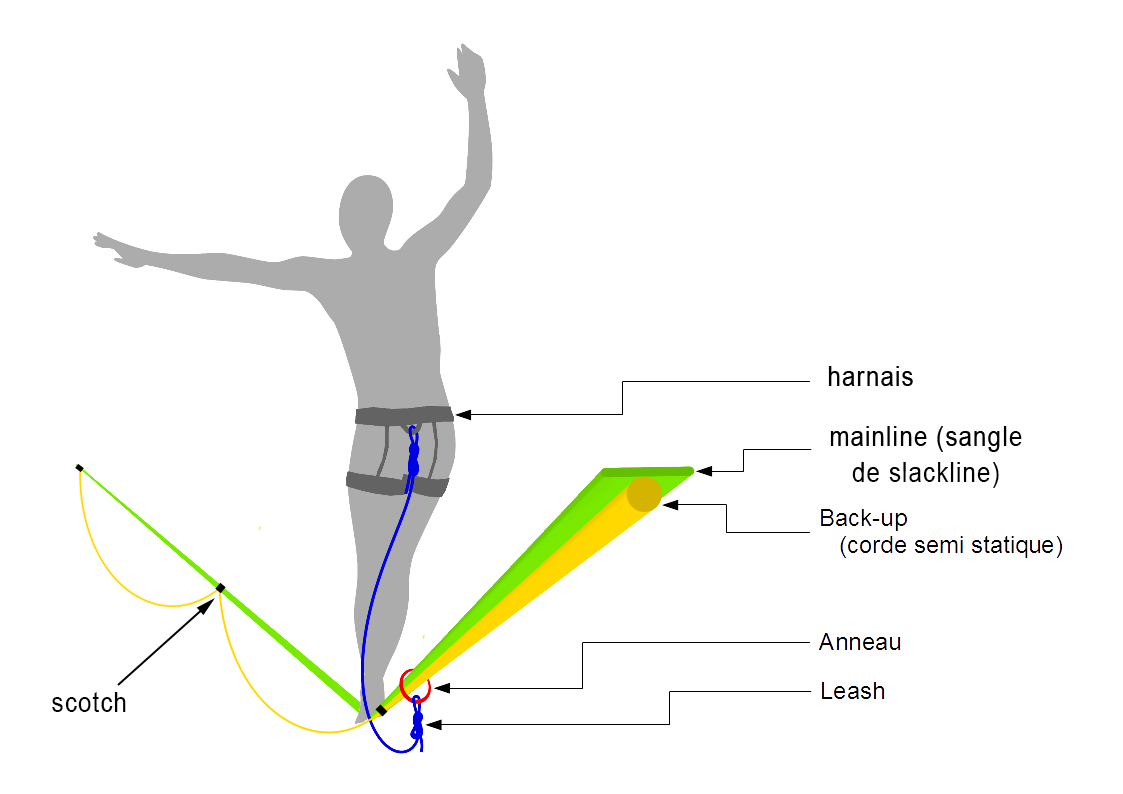
source : wikipedia/Highline
In this video, you will go behind the scenes of the 2016 world record, a one kilometer crossing (now broken). There, we explain in detail the process of rigging the highline.
Please note that is not a typical rigging processs. The rigging was done by experts for the specific purpose of a world record. Don’t reproduce it as is.
2. Highlining 7 commandments
#1 Never practice alone
As in mountaineering, for obvious safety reasons, you should avoid setting up or crossing the highline alone. There are enough clubs, associations, and Facebook pages to be able to connect with other confirmed highliners. You will find highline spots and communities in the « Where to practice slacklining ? » section.
We also invite you to take out FFCAM or FFME insurance policy from clubs with a slackline section. (France only, written as an example)
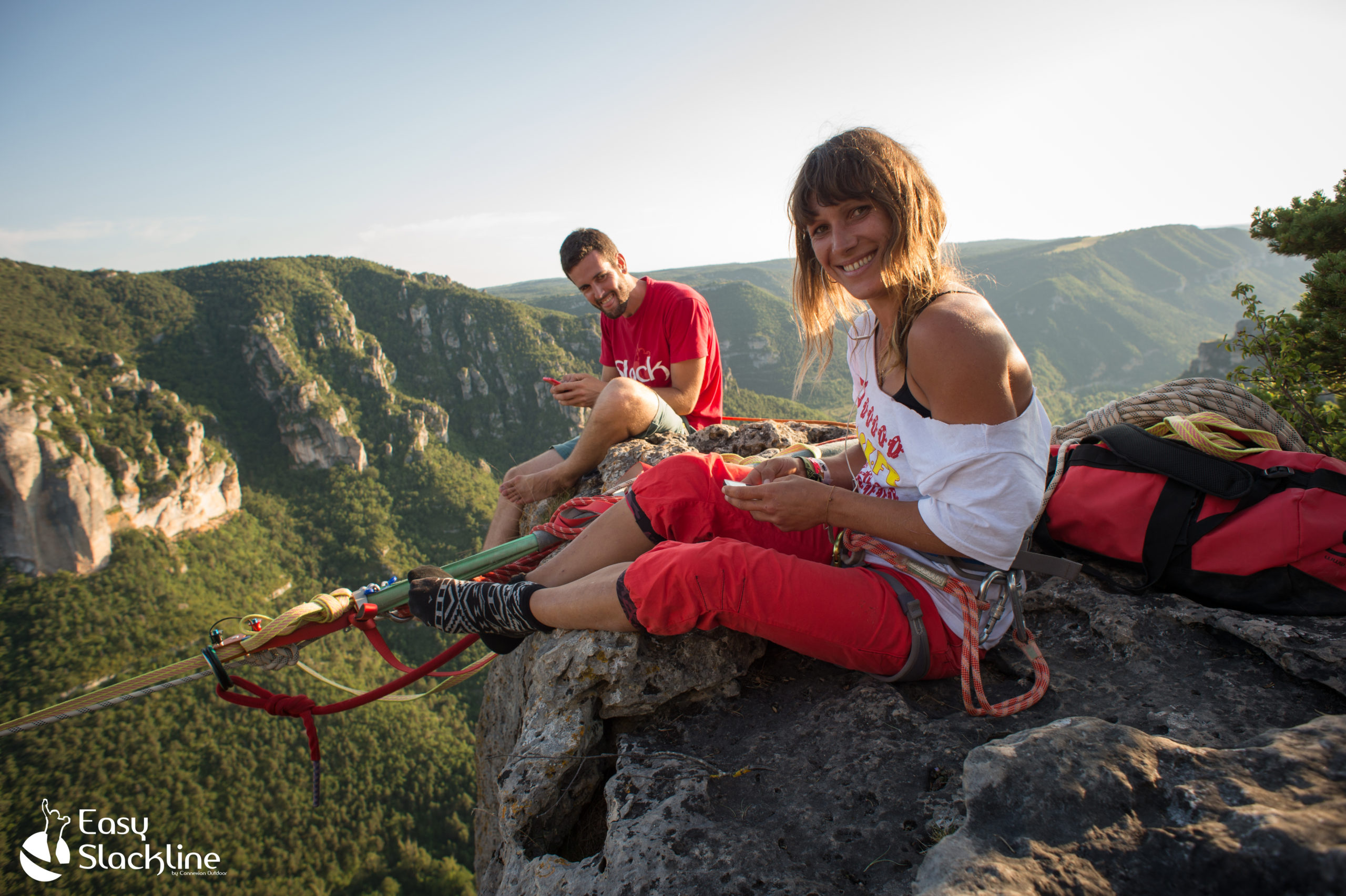
#2 First setup
We strongly recommend you to find a tutor / mentor to teach you how to install your first highline.
A tutor can teach you the basics and help you avoid serious mistakes of the first-time installations, whether it is a real highline or a treeline (highline in the trees).
The tutor is not responsible for you, he/she is only sharing his experience with you. You are responsible for your installation and for yourself.
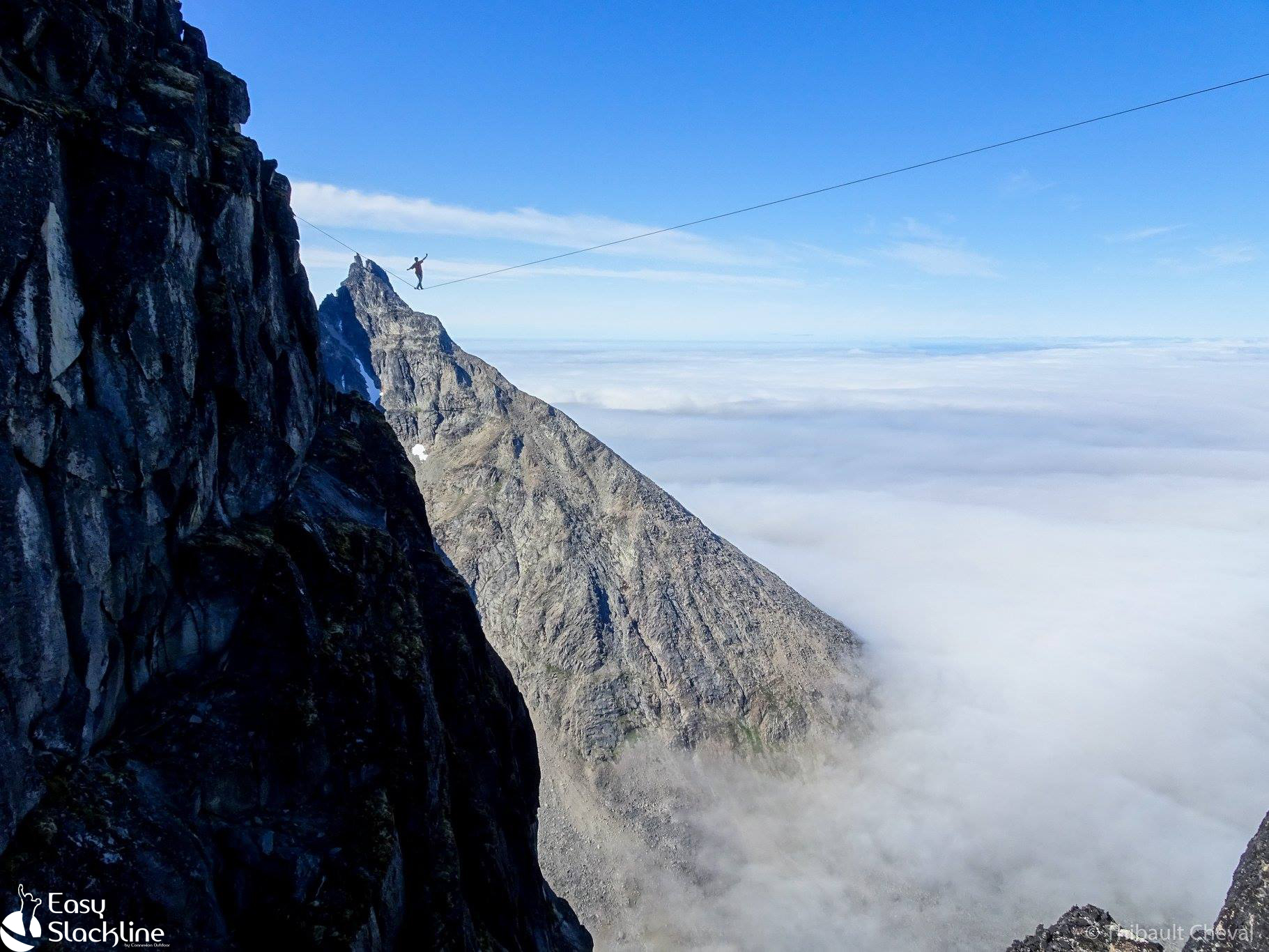
A common mistake is to start in trees, with “usual” slackline material, and without a lifeline. The treeline seems accessible because trees are everywhere and there is need to go to the mountains or near the edge of a cliff.
However, the problem with the treeline is that too often the slackline is installed at low height (4, 5 or 6m high) – the trap is there :
“There is no maximum height in a highline, but a minimum height!”
The higher you are, the lower the risk of falling back to the ground, or even zero.
By achieving a perfect installation according to the state of the art rules, you will be able to practice in complete safety.
We don’t want to provide a ready-made guide « how to start highlining ». Why ?
Simply because it’s a practice that requires adequate and specific installations, adapted to each place. The same technique will not necessarily be adapted for the installation in two different places.
We prefer to insist on sharing your first steps and first installations with experienced people, or even better during courses organized by slacklining associations.
Highline workshops by Slackicimes, with the support of Easy Slackline
#3 Know your equipment
A theoretical knowledge of the installation is essential. The International Slackline Association provides some keys.
You can first practice by rigging on the ground. This will also allow you to check all your equipment in case for your forget something. Knowing all the characteristics of your equipment allows you make a real opinion on the validation of the installation, which is absolutely mandatory.
Ground rules to know concerning the equipment :
- Try to avoid aluminium/zicral parts, with exception for weblocks
- Avoid carabiners, prefer the use of shackles or quick-links
- Do not use ratchets or beginner’s kit (e.g 5cm large webbing)
- Get an independant lifeline, preferably normed as PPE (unless otherwise specified, a slackline webbing is not a PPE – prefer the use a static climbing rope)
- Use a sleeved leash, a pair of leashring, and a climbing harness to secure yourself on the main and backup line – More informations on leashes
- Prepare a kit to rescue an injured or unconsious highliner stuck in the midlle of a highline
#4 Choose the right spot
Get know your environment :
- Opening : For a first attempt, avoid line openings (place free of any highline), rather contact a local or a group – hence the second point
- Repetition : Prefer to repeat a classic, read the existing recommendations. Contact the first riggers to take the appropriate equipment with you and learn about the dangers and problems in the area.
Sufficient heigth : Correctly measure the size of your leash, and the length to heigth ratio of your line - Anchor points : Check them at each installation. Always take a hammer to check the quality of the rock. Get enough anchor points to split the forces according the tension needed.
A hand drill is not heavy and always useful to drill a new hole for an anchor if necessary - Cutting edges : must be protected to avoid abrasion and cuts on webbings, slings or backup ropes.
Also consider protecting the backup from potential failure
#5 Requirements : Know your limits and those of the equipment
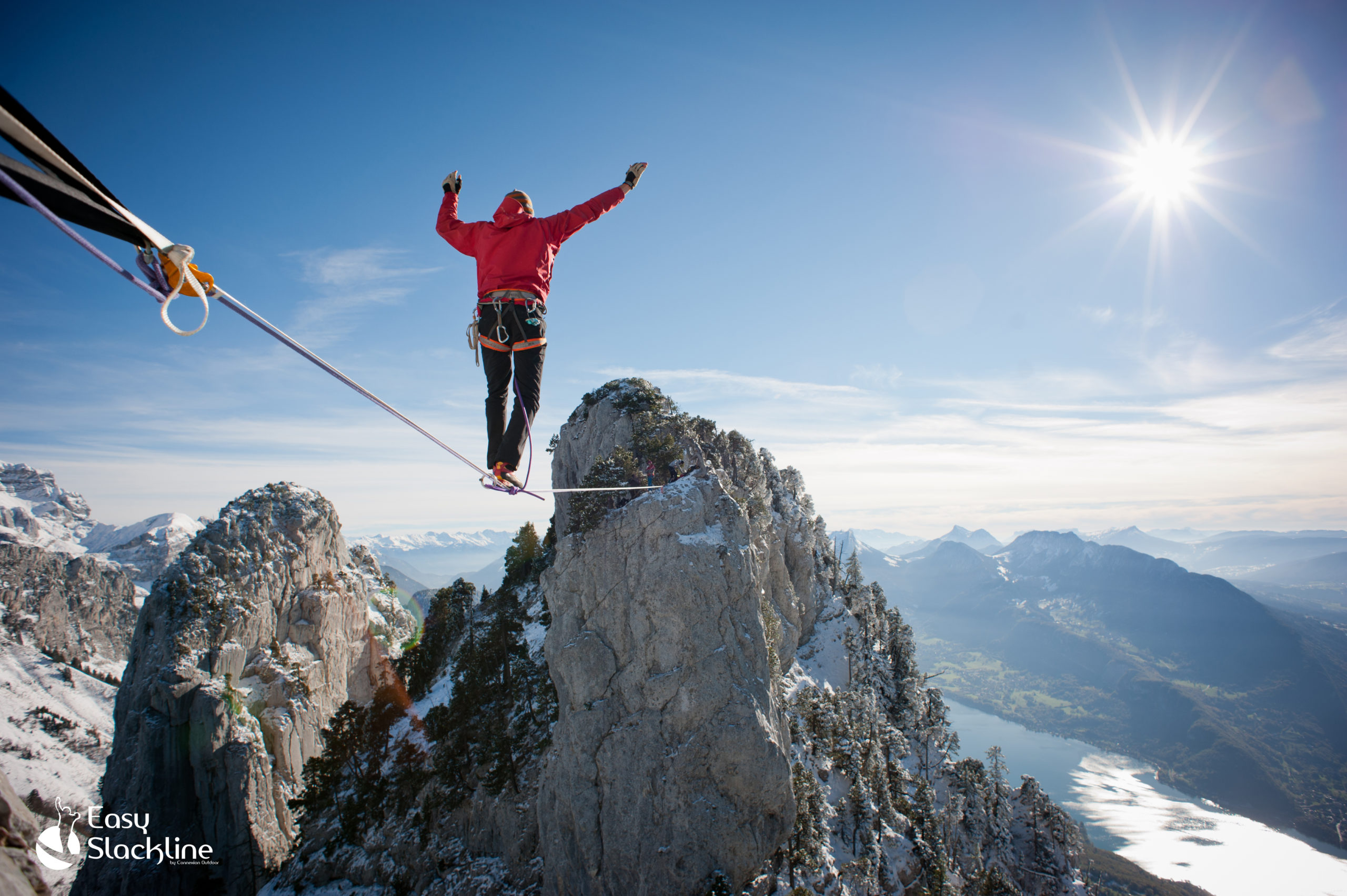
- Starting slacklining with highlining is not recommended. It is better to have some experience and a certain level before starting it. A good way to train is to waterline – we explain why here
- Be in good physical condition
- Know the knots that are essential for rope climbing and for making it safe in a potentially dangerous environment: figure 8 knot, safe/off belay, rappelling technique, etc
- Slackline techniques : Possess the following prerequisites (practice them on a waterline):
-
- Know how to do a sit start (chongo start, sit start): Falling into the air, the void, it is scary. But falling against the cliff hurts!
- The sit start allows you to start the crossing far from the edge, without the risk of swinging in case of a fall and hitting the cliff
- Knowing how to go back up on the leash: Yes, once you have fallen, hanging from the extremity of the leash under the highline, you have to know how to go back up to catch the highline and come back to the starting point by yourself!
- Here you can check out our article on our blog about the first steps on highline
-
- Human redundancy : Anyone wishing to cross a highline must have validated/verified the installation. Riggers should have their installation checked by another person to avoid leaving a carabiner, shackle, delta open, making an american death triangle, or using too much worn or inadequate material. Remember to check the whole system but also your anchor points (check the quality of the rock)
- Buddy-check = always « buddy check » your leash knot before you start (most accidents are caused by a leash unproperly tied)
- Material redundancy : Always double your equipment and if possible with unused gear. Backup made with a slackline offer less safety than rope backup (sport and leisure PPE standard) and should be used with full knowledge. The backup is not intended to be done with your old gear or the remains of your equipment
- Separate slackline and climbing equipment: If you practice climbing, the equipment used for slackline/highline should not be used for climbing. Because the strengths and especially practices are not the same, you can’t properly assess its aging and you are potentially putting yourself at risk by mixing your equipment
#6 Safety
-
- Leash : Bring your own leash. Know how to tie a figure-eigtht
- Buddy-check : always check twice. Principle of « human redundancy » as mentionned before. The vast majority of incidents because of the lack of respect of this principle. Human flaws are the biggest risk
- Rescue kit – PPE equipment : long enough ropes in required quantities. Carabiners and quickdraws – First aid kit. Fully charged phone
#7 Respect people and the environment
- Fauna and flora: Be careful not to highline in protected areas.
Nowadays, some areas require municipal authorizations (e.g. Gorges du Verdon). More informations in the “safety / legislation” section -
Private or registered areas (e.g. climbing sites) : Please do not drill everywhere without thinking about the consequences of your actions. Do not use climbing belays. You are responsible not only for yourself, but also for the reputation you give of slackliners and highliners. You are responsible for the facility/spot/other on which your equipment is installed.
Notify the locals. Watch your line. Remember to regularly check your installation.
Take a look at the anchors points before each crossing.
3. Where can I highline, Who can I highline with ?
Finding a nice spot is great but it’s also important to first think about respecting the active rules on it. To help you in your efforts, we have established a collaborative contact list on the following page : « Safety – section 4 »
Highlining is mainly practiced in the mountains. We talk about « highline » when it’s necessary to secure oneself with a leash and a climbing harness.
To find the highline spots or slackliners communities, please visit the « Where can I practice » section.
There also other ways to practice : outdoor sports festivals such as Natural Games, or slackline festivals where you can come and see slackliners crossing highlines, or even cross one yourself (under conditions of course and if you’re skilled enough). To know the next events organized : please visit our « events » section.
4. Requirements equipment
As previously explained, there is no ready-made, comprehensive list for highlining.
It is up to each person to TAKE RESPONSIBILITY by doing research and going to discuss with experienced highliners or take part in a workshop to find out what equipment will be necessary for a particular installation.
But here are some important points to keep in mind:
-
-
- The slackline you walk on (mainline), must be completely independant from the lifeline (backup). The fundamental safety principle is equipment redundancy (human redundancy also, as we know more now about accidentology)
- Leashrings are connected both to the main and backup line
- Use PPE equipment for the backup line
- Do not highline too low, close to the ground. The longer the highline, the higher it should be
- Common equipments (such as ratchet kits) for beginners are not suitable for the highlining.
-
